Comparison of Popular Outsourcing Models: Which One Is Right for You in 2024?

It’s tough to decide whether or not to outsource because there are a bunch of different outsourcing models in 2024 to choose from. With so many options, it’s no surprise that this decision can be really difficult and has a huge impact on how well outsourcing works for your business. Your choice can make or break your outsourcing strategy and affect how much you benefit from working with a vendor.
Each model has its unique advantages and disadvantages. The choice of the right model will help you:
- Drive innovation. From 2018 to 2022, Deloitte found an increase from 49% to 76% of companies starting to outsource as they innovate.
- Gain access to top talent with the right expertise. 75% of companies face difficulties hiring qualified talent.
- Make smarter use of your resources. A strategic approach to outsourcing will help you fill skill gaps and keep up with the dynamic market.
So, done correctly, software development outsourcing can become a powerful strategy for achieving your business goals.
In this guide, we’ll compare different types of outsourcing services to help you decide on the best option for your business needs. We’ll review the benefits and drawbacks of each model, explain why and when each is used, and show how they can help advance your digital initiatives and improve the bottom line. So, let’s dive in and explore all the nuances of outsourcing.
What is Outsourcing?
Essentially, IT outsourcing means hiring a third-party company to handle your IT needs or developing digital products. It’s a way to get access to the technology and expertise you need to keep your business running smoothly without building and maintaining your own IT department.
By outsourcing such processes as software development or maintenance, you can focus on running your business while leaving the technical details to the experts. This can save you time and money and help you stay ahead of the competition by keeping up with the latest software solutions and technology trends.
Why Do Companies Choose To Outsource?
Despite the looming recession, the forecasts for the global IT outsourcing market anticipate an increase at an annual growth rate of 8.07% between 2024-2027. The industry was worth $395 billion in 2022 and will climb to $430 billion in 2023. So, we can see the tendency toward more businesses opting for outsourcing, but what makes them decide to do so?
Outsourcing has become popular as a strategy for SMEs and larger companies alike. Instead of building capabilities internally, business leaders increasingly leverage IT outsourcing to support their business and technology operations. We can confidently name cost saving as a primary reason for 57% of business owners. Other most common motives are:
- Gain access to new capabilities
- Increase efficiency
- Facilitate growth
- Onboard short-term expertise
- Access global talent
- Improve flexibility and productivity
- Keep pace with the rapid technology and digital transformation
- Gain a competitive edge
- Share risks with a partner company
It can be difficult juggling everything in-house. That’s why, as a business model, outsourcing allows you to allocate the time and resources you need to focus on core business aspects while still providing customers with high-quality service.
Now let’s evaluate various IT outsourcing models and determine which to choose for particular technology needs.
Location-Based Types of Outsourcing
A successful outsourcing model goes beyond cost and expertise and considers such crucial aspects as time zones, cultural similarities, and strong tech infrastructure. We took it into account when comparing the best countries to outsource software development to. Hence, the location of the IT outsourcing services company is one of the most important considerations. The main deciding factor here is how far your outsourcing team will reside from you. Let’s review the options.
Onsite Outsourcing
This delivery model refers to hiring an external company or contractors that provide services or perform tasks in the physical location where your company operates. As such, the vendor will select and send qualified IT experts to work in your office for a fixed period of time.
The onsite team directly coordinates and collaborates with your internal team. Together, they collect information and develop, implement, and maintain the project. Basically, an onsite team functions like your in-house staff. The difference is that they are not technically your employees, which leads to the following benefits.
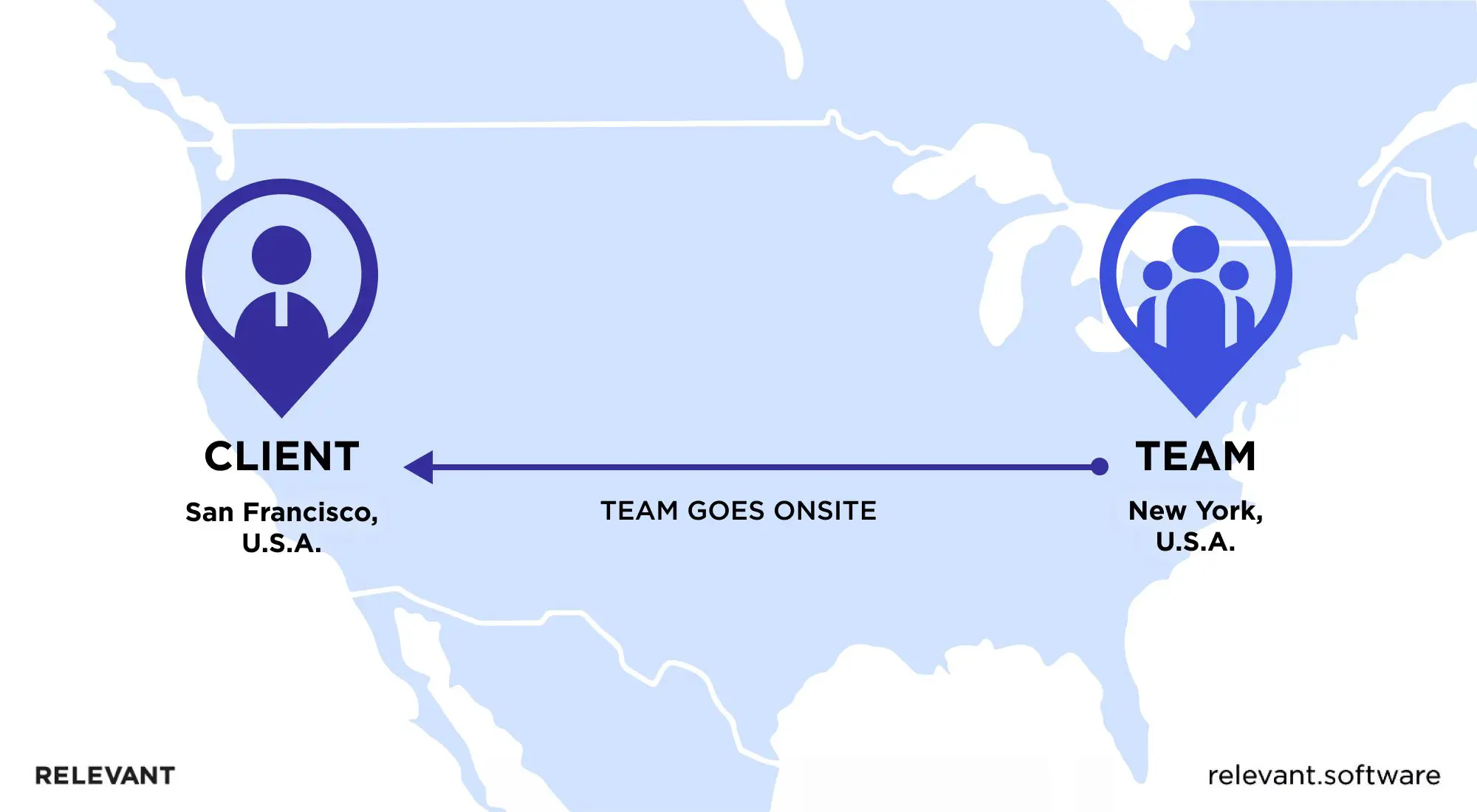
Advantages:
- Quality control enables you to closely monitor the work and provide feedback in real-time, ensuring it meets your standards and expectations. On-time detection of emerging issues will lead to efficient problem-solving.
- Faster adaptation. Working onsite, side-by-side with your personnel, results in quicker familiarisation of your external team with your systems, workflow, and processes.
- Effective collaboration. There is no time and distance gap, so the teams collaborate smoothly without any misunderstandings.
Disadvantages:
- High labor costs. Small to no cost savings since the salary will be relatively similar to in-house staff.
- Costs associated with direct staff support. Moreover, you have to provide office space, desks, parking spaces, and other office stuff for the onsite workforce.
- Very limited labor market. When hiring locally, you limit your search for talent to a single region. The diversity of skills and quantity of experts available in your region might be insufficient to meet your needs.
- Team management. You should assign managers to supervise and support the extra personnel coming into the office. The lack of clear management can create chaos. As a customer, you set tasks, and the outsourced team implements them, but the task execution and final results will depend on the joint efforts of your internal staff and onsite experts.
- Security risks. The outside team will have access to your sensitive corporate information, which could pose a security risk if you don’t take proper precautions.
When to choose:
- Projects without specific requirements. If you have an idea that you want to validate through building an MVP or any other project without specifications because they will evolve, this model is a perfect fit.
- Collaborative projects. The onsite model is the most beneficial when your project requires continuous interaction between your in-house team and outside specialists.
- Improvement to the existing systems or introduction of new technologies. A simple and fast exchange of information that onsite outsourcing offers will guarantee the best results in this case.
With proper planning and understanding of the risks, close cooperation between your specialists and the development team can bring amazing results. But it’s just one of the outsourcing models. Let’s move further.
Onshore Outsourcing
Onshoring means partnering with an IT service provider within your country but not necessarily in your city. The main difference between this approach and onsite outsourcing is that you work alongside your external team from different physical locations. So, why consider this software outsourcing business model?
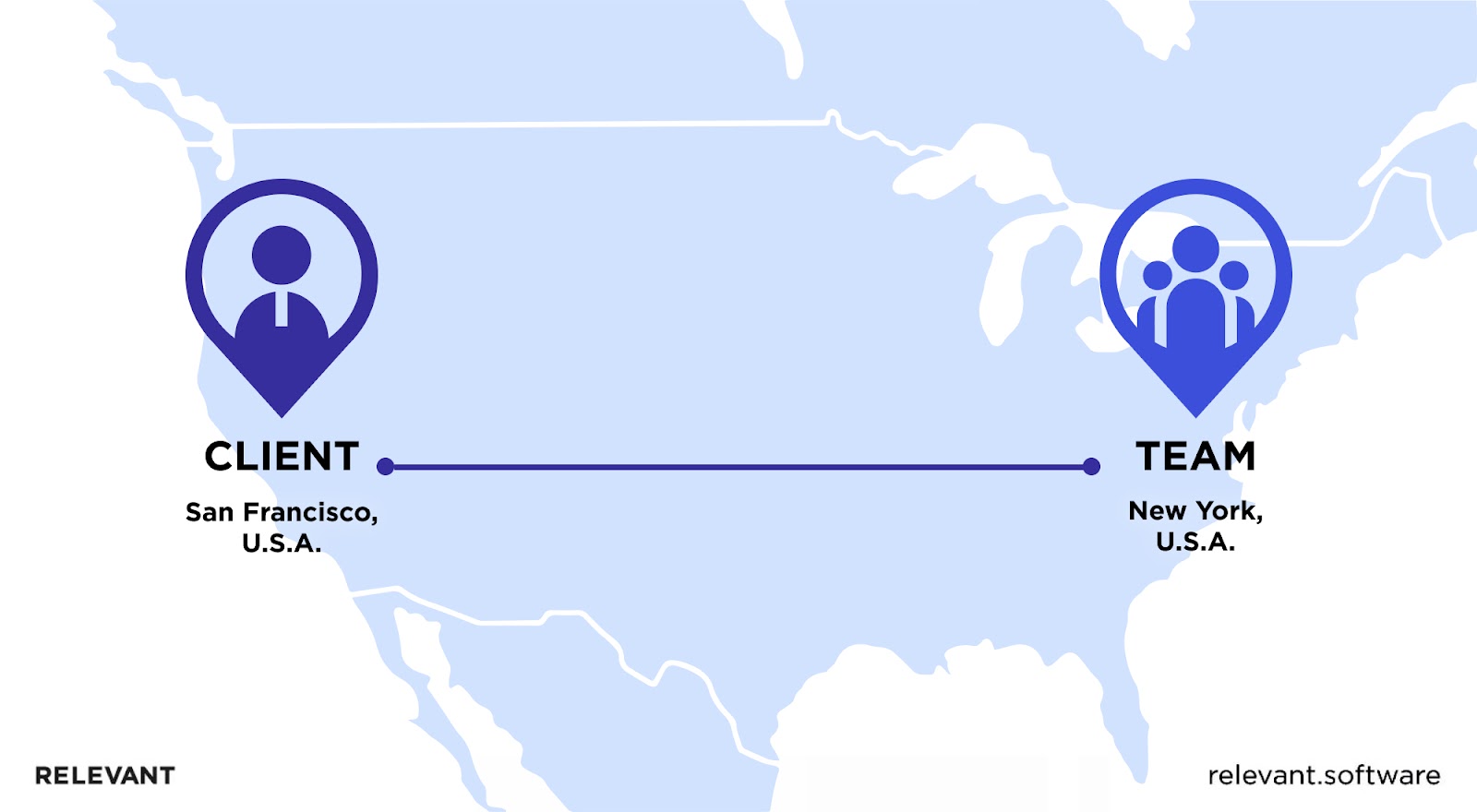
Advantages:
- Convenience and seamless transition. Since you’re both from the same country, there will be no language barriers or cultural differences. The same goes for a time zone which will be the same or minimal if you live in large countries like the US or Canada. In addition, the identical work culture will result in the outsourced team immediately getting to work on your project with the slightest adaptation.
- More control over the process. You can react quickly to issues and make necessary changes to projects due to close collaboration between teams and offices. However, managers won’t have direct oversight over outside teams that work remotely.
- Cost savings. You save on training, healthcare, and employee benefits – standard expenses associated with maintaining an in-house team.
Disadvantages:
- Still a limited talent pool. There is no guarantee that you will find the right talent for your needs, as onshoring limits the pool of candidates available. As a result, you face a lack of qualified specialists or end up paying high developer rates.
- High labor costs. Local hiring might not be the cheapest option, especially if your business operates in the United States, Europe, or Australia. Although onshore outsourcing provides cost savings in some areas, labor costs are very high.
When to choose:
- Data security regulations. Some IT functions involve access to strictly regulated data that requires staff performing those functions to be in the same country as the data itself.
- Easier communication over price. If you have a large project budget and can bear the higher developer costs in exchange for seamless communication and a high-quality team of experts.
- Onsite collaboration. If you want to visit your external team, travel time and cost will be kept to a minimum while you benefit from faster project completion.
Offshore Outsourcing
The other end of the spectrum is an offshore type of outsourcing, which implies hiring software engineers overseas, 6+ time zones away from you. For example, your company from the US outsourcing software development to Eastern Europe or India illustrates offshore cooperation. So, what will bring you this outsourcing model?
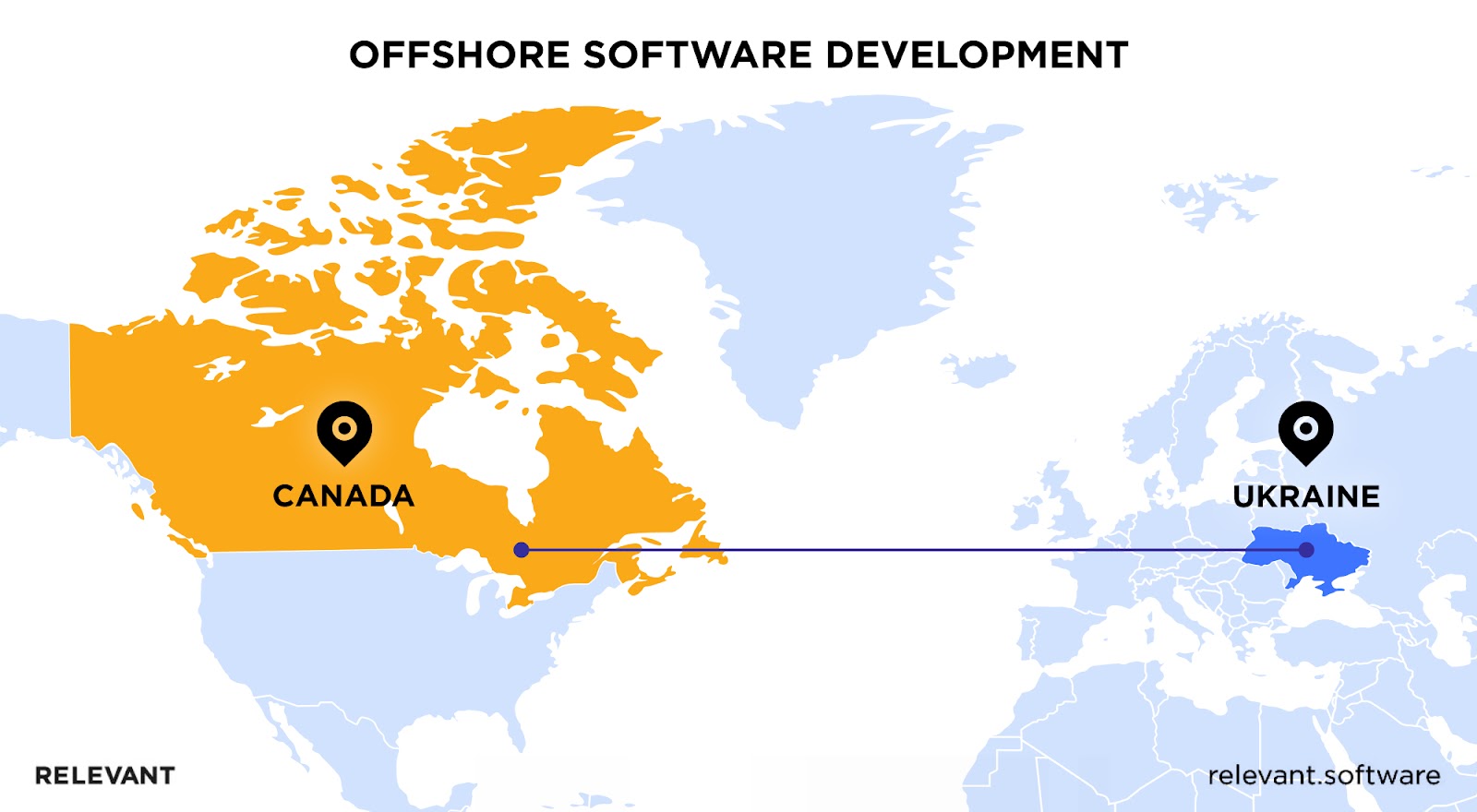
Advantages:
- Massive cost reduction. While the cost of working with IT experts overseas can vary, cost-efficiency is the undeniable benefit of offshore software development. Labor and other resources are generally the cheapest in Eastern Europe, India, China, and the Philippines.
- Access to global skilled labor. You can find qualified professionals with niche skills, specialized knowledge, and experiences that might be difficult or impossible to find locally. In fact, the diversity and number of talented IT experts are the main benefits of offshore outsourcing.
- Great flexibility. It’s you who defines the number of outsourced staff. If your business experiences a sudden surge in tech talent demand, you can quickly and easily ramp up your team. And if your business slows down, you can scale back effortlessly without worrying about layoffs or severance packages. This can be particularly valuable for small or growing businesses.
- Reduced operational costs. With offshore outsourcing, you save operational and maintenance costs while improving productivity.
Disadvantages:
- Cultural barriers. Working with people from different cultures and time zones can lead to misunderstandings and delays, which can, in turn, impact productivity and quality.
- Time zone difference. Finding the appropriate time to communicate with your offshore team can cause communication gaps. The lag times may affect time-sensitive and deadline-driven tasks. Yet European developers have adapted their working hours to overlap the 7-hour time difference with the US clients, which is harder for Asian workers with their 9+ hour difference.
- Security and confidentiality risks. Unlike the EU’s high data security standards and privacy regulations like GDPR that protect client information, India is only developing comprehensive data protection legislation. In this regard, outsourcing to some Asian countries poses greater security threats than outsourcing to Europe. So, ensure a foreign country’s legal infrastructure protects Intellectual Property rights.
When to choose:
- Full project outsourcing. If you need a reasonable balance of price and quality, you may delegate full product development to European vendors with an overlap in working hours that simplifies communication.
- Projects requiring specific expertise. If, after researching the local market of tech specialists, you realize there are no experts to meet your project’s needs, then offshoring is a perfect option for you.
- 24/7 technical support. Today’s customers demand 24/7 service. By capitalizing on workers in different time zones, offshore outsourcing gives you a more feasible way to offer round-the-clock technical support.
Nearshore Outsourcing
Today, organizations are looking to expand their external staff to neighboring regions such as Eastern Europe or Latin America instead of India. In other words, businesses found the nearshore outsourcing model attractive for cost reduction and long-term innovation. So, as you might guess, nearshoring is when you contract with an IT service provider located in a nearby country or region. Nearshore software development services are worth your closer consideration as this model can give you the best of onshoring and offshoring while reducing the risks of the latter. So, let’s dive deeper.
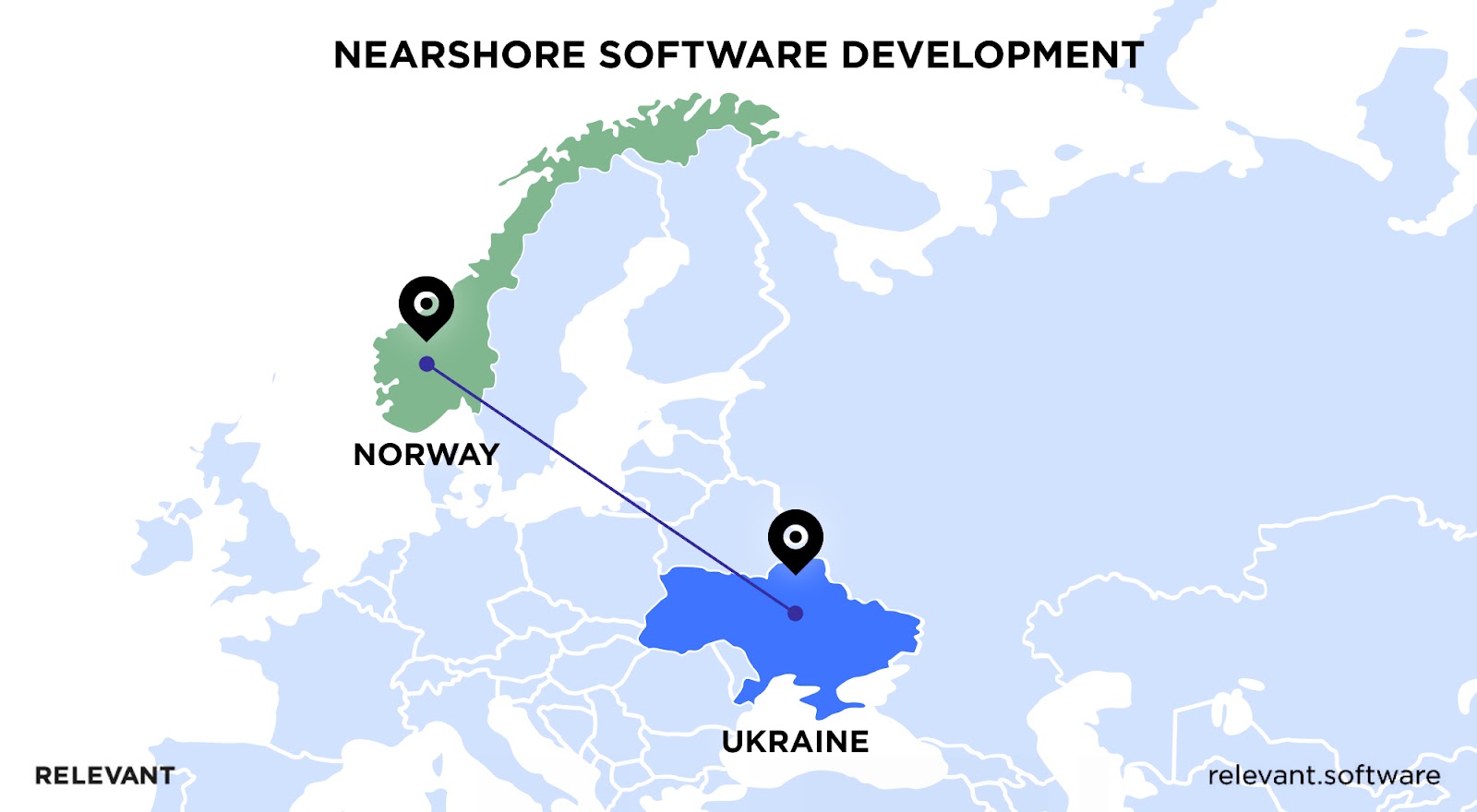
Advantages:
- Cultural alignment = seamless team integration. It’s much easier to collaborate with a team that shares the same working and business cultures as yours. Due to this, a nearshore software development outsourcing team will integrate faster into your company.
- Small to no time difference. The geographical proximity of the software development team reduces any time zone lag, enabling timely communication and facilitating project coordination during standard business hours.
- Cost-efficiency. In addition to avoiding expensive in-house hiring practices, you save on operating and maintenance costs. You’ll also find nearshore software development rates lower than onsite or onshore, especially if you’re operating in the US or Western Europe.
- Perfect price-to-quality ratio. While the costs of hiring nearshore developers are higher than in India and the Philippines, you may be sure to get top-quality work.
Disadvantages:
- Limited resources. The number of talents in nearby countries might be limited compared to boundless offshoring opportunities.
- More expensive than offshoring. Sourcing talent offshore from countries with larger labor pools, like India, is a cheaper alternative to nearshoring.
When to choose:
- Full project development. Tasks that require close collaboration between the extended team and project stakeholders.
- Agile projects. Nearshoring is the best solution for your agile projects since the communication with the outsourced team will be seamless. And this is the key success factor in the agile development approach.
- Custom development and large projects. Partnering with a nearshore outsourcing company close to home will benefit you if your project release and management require regular on-site visits from both sides.
More details on this outsourcing model you can find in our in-depth guide on nearshore software development.
Multisource Outsourcing
Why limit your choice to one model when you can combine several or all of them? Multisourcing leverages the benefits of numerous vendors residing in various locations, unlike traditional sourcing, which deals with a single company. If done properly, multisource outsourcing helps you partner with the best-fit talents for each part of your project or IT service while reducing costs and getting real value.
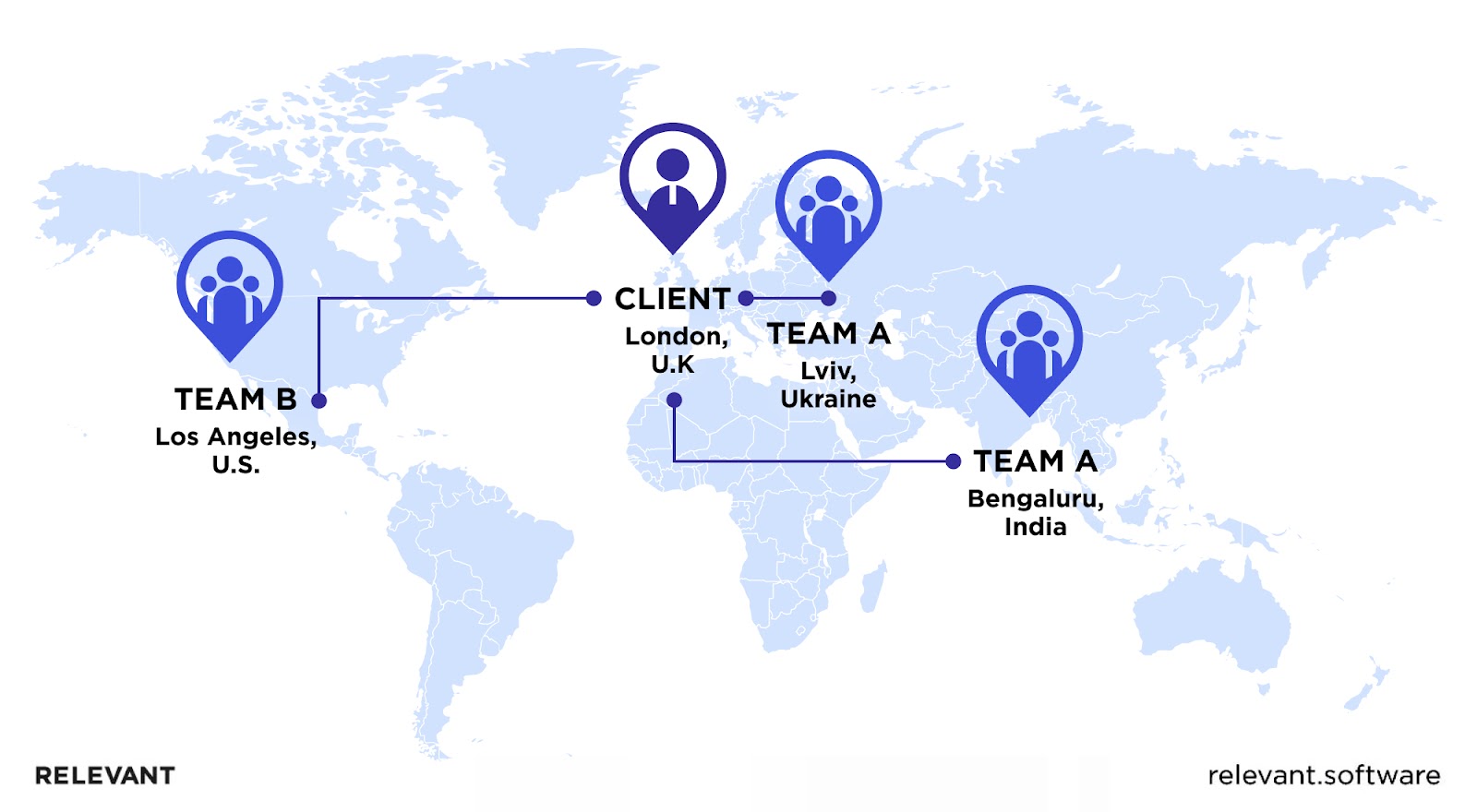
Advantages:
- No resource limitations. Finding specialists in specific and niche areas is much easier as you can search all around the globe.
- Extreme flexibility. You can hire highly skilled professionals to work on critical project areas while outsourcing some repetitive work and less complicated tasks to cheaper specialists. Plus, you aren’t locked into single contracts with service providers who aren’t delivering desired results in all areas.
- Reduced risk. As you work with multiple vendors, you lower the risk of disruption to product development. If one of the outsourced teams fails to complete the task, it would be just one of the parts of your project. Moreover, multisourcing allows you to switch to another provider of the same services easily. The switch to a traditional outsourcing model will be more tricky and harder as a single provider handles multiple systems and processes.
Disadvantages:
- Hurdles of managing multiple teams. The more vendors you cooperate with, the more you should focus on managing and overseeing them all to avoid collapses. Moreover, the administration of multiple contracts and agreements will require more internal resources to check reports from their providers and evaluate their performance.
- Difficulty in sharing information. Effective collaboration relies heavily on exchanging information, but when you’re cooperating with numerous companies to develop your product, it can turn into a mess.
When to choose:
- Complex projects. When your project has many parts that can be developed individually so that one team’s work doesn’t depend on another team’s results. For example, microservices-based systems.
Comparison of Location-Based Types
Our summary table highlights the most crucial aspects of IT outsourcing models to help you make the final decision.
| Key factors | Onsite | Onshore | Offshore | Nearshore | Multisource |
| Talent pool | Very limited | Limited | Broad | Sufficient | Broad |
| Cost efficiency | No | Little | High | Medium | Medium |
| Time zone difference | Same | Same | Significant | Slight | Depends |
| Cultural alignment | High | High | Low | Medium | Depends |
| Communication efficiency | High | High | Low | Quite high | Low |
| Expertise | High | High | Medium | High | Combined |
| Risks | No | Low | High | Medium | Low |
We provided a detailed review of the most popular types of IT outsourcing, where the location is the main deciding factor. As you can see, the proximity of your outsourced team influences numerous aspects vital for effective collaboration. Also, it’s worth noting that different projects require different solutions and different outsourcing models.
But wait, we are far from ending our review. Just keep reading to get an overview of other options that will define the partnership and pricing models of your cooperation with a vendor.
Relationship-Based IT Outsourcing Models
Another critical decision is determining the type of partnership with the outsourcing company. It all goes down to management and the distribution of ownership and responsibility between your organization and the outsourced team. So, let’s see how it works.
Staff Augmentation
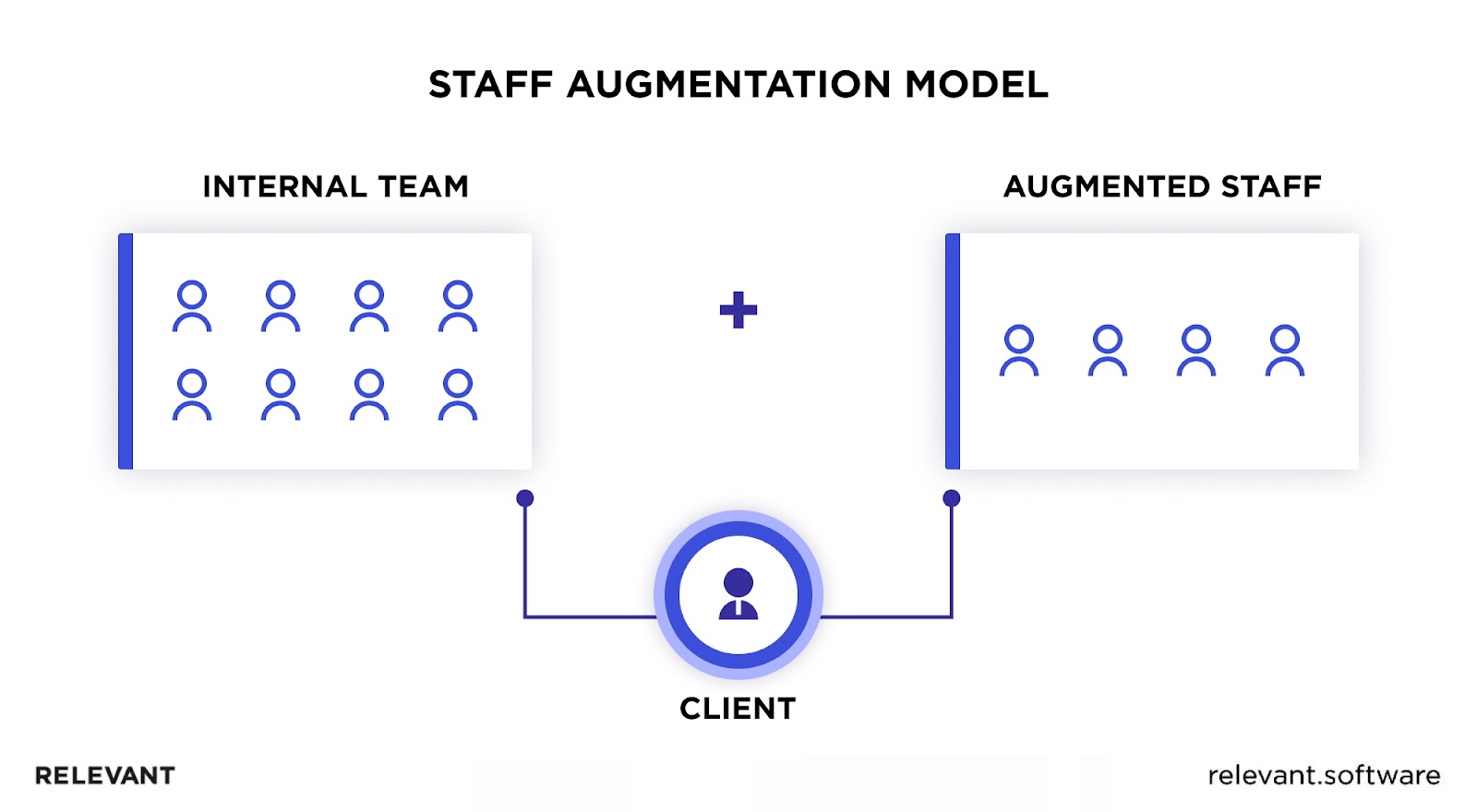
Imagine you have a team of experts working on a project but lack a QA specialist to ensure proper product functioning. It makes no sense to go through a lengthy and costly hiring process if this is a one-time requirement, and you’d be right. That’s where a staff augmentation model will help you complete your project on time or fill a skill gap. It’s one of the cost-effective ways to extend your software development team, especially beneficial for short-term cooperation.
Using this engagement model, your outsourcing partner will provide specialists that will become a part of your in-house team onsite or remotely. Basically, it’s similar to hiring an employee but with the added benefit of not having to worry about onboarding and training. In this model, you have full control over the team and project management as well as the responsibility for the deliverables. Thus, you can maximize the efficiency of your in-house team while maintaining control over your project.
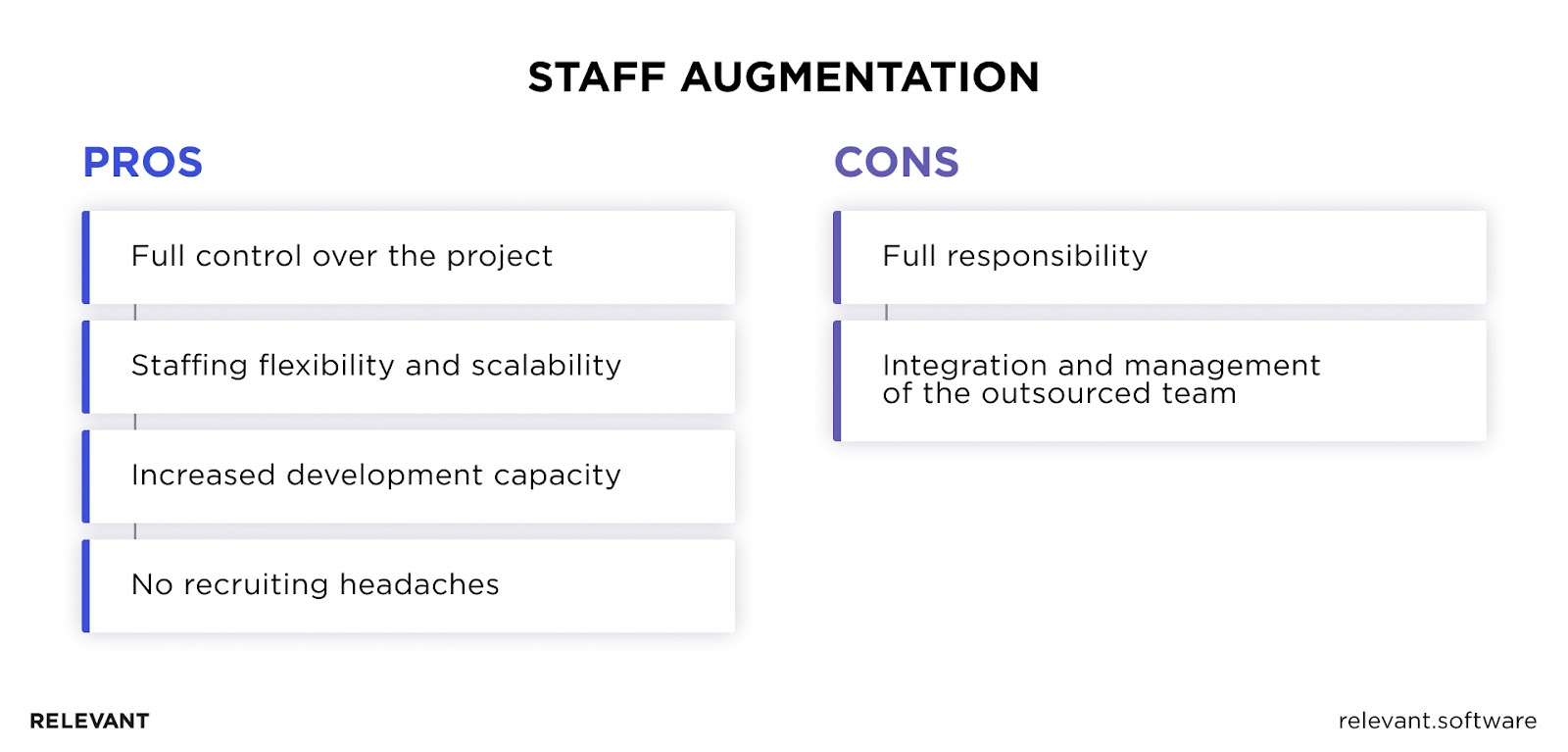
Dedicated Team Model
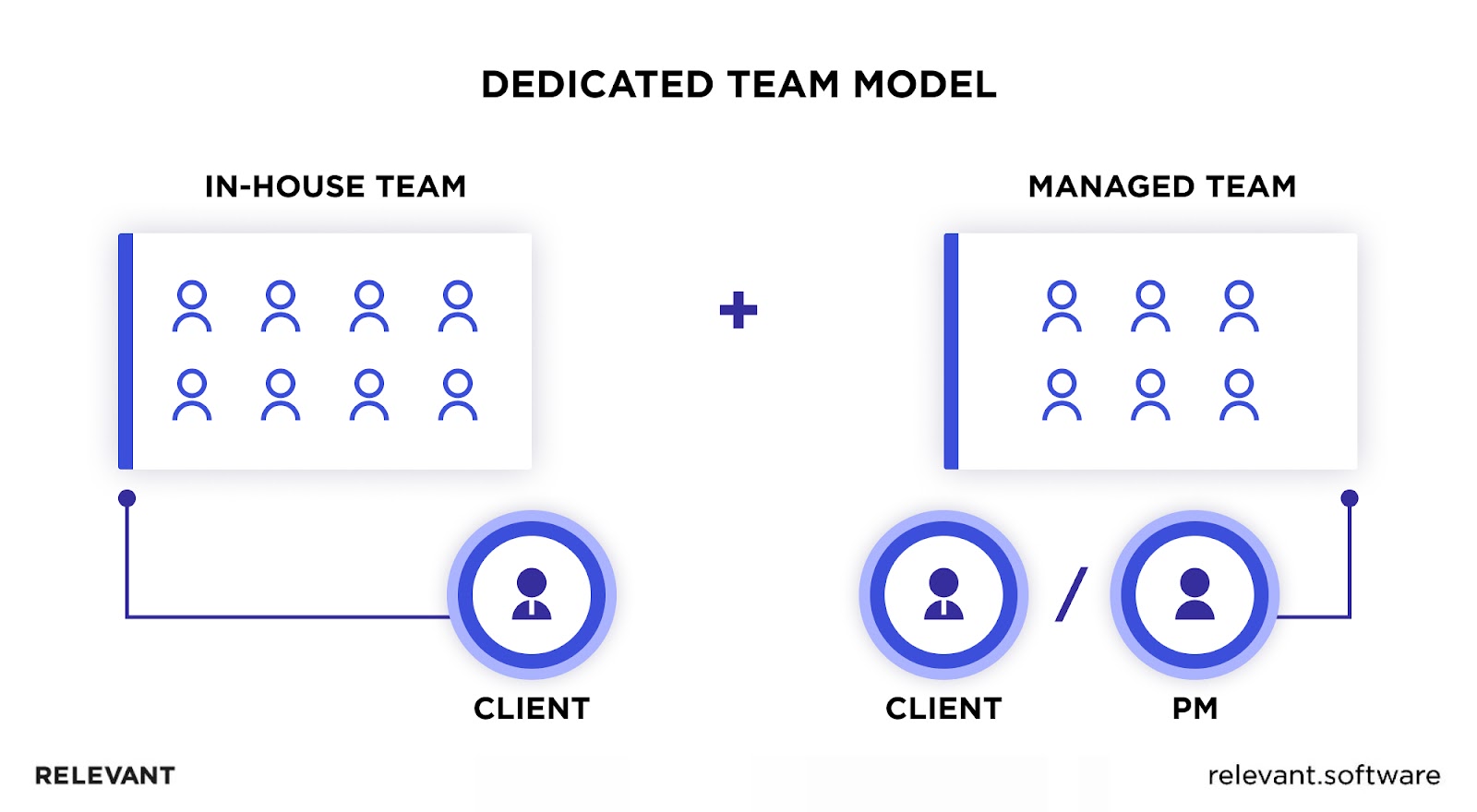
By choosing this cooperation model, your outsourcing partner will set up a team of experts exclusively dedicated to your project. The dedicated team may consist of various roles as per your project needs, including software engineers, business analysts, designers, QA specialists, and project managers. The size of a team is also up to you. Consider it some sort of staff extension, yet it doesn’t involve direct collaboration with your internal team.
Opting for a dedicated team model, you will share the risks and responsibility for project results with the outsourcing company. You will find a dedicated team the most beneficial for complex, long-term projects that require a high level of expertise.
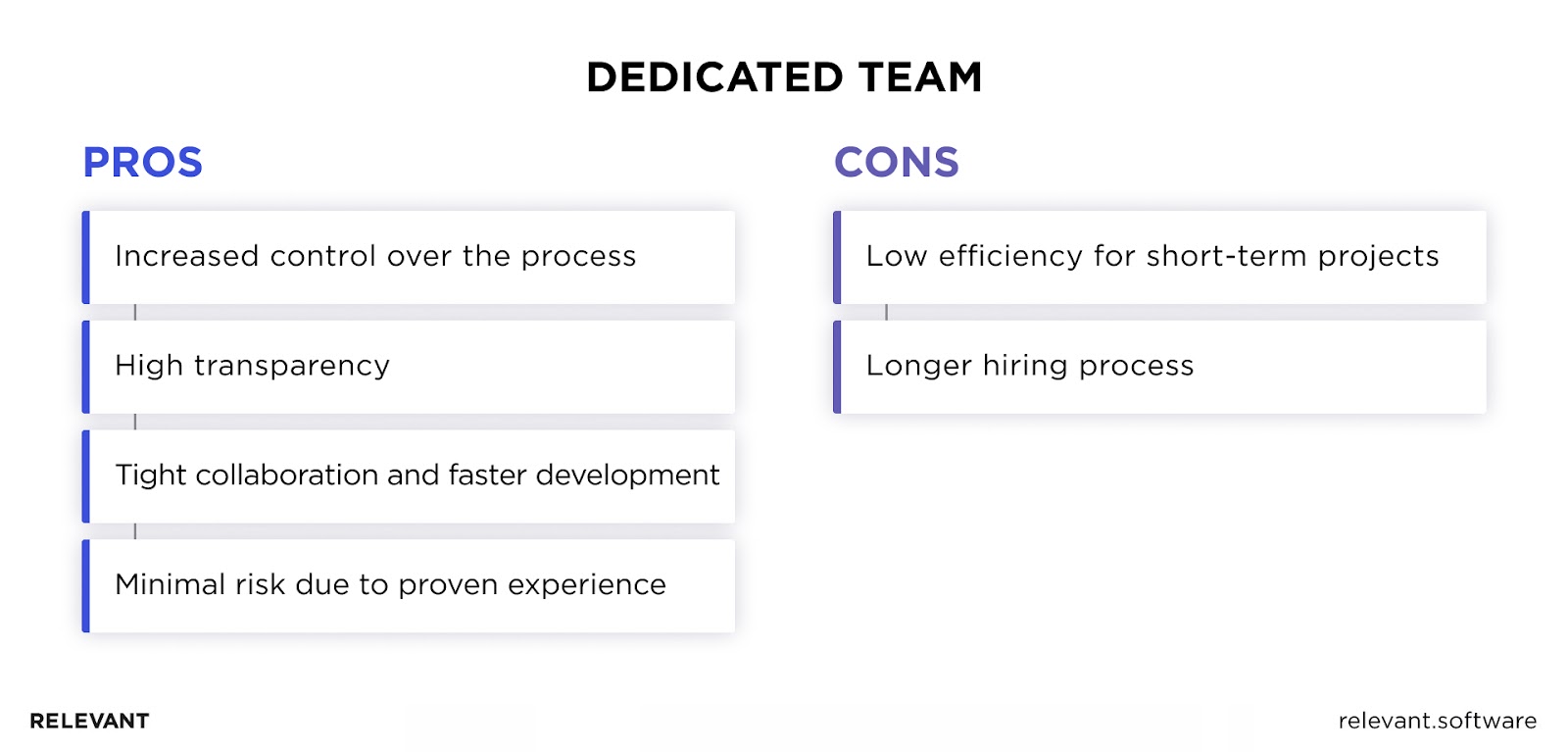
We recommend you check our article on how to find and hire a dedicated software development team to learn all the nuances of this outsourcing model.
Project-Based Model
Unlike previous outsourcing models, you delegate the whole product development and management to your software outsourcing partner. All you need to do is ensure your specifications and requirements are well-documented and communicated. You don’t necessarily need any technical expertise because the development company completely takes over the project and lets you focus on your core business operations.
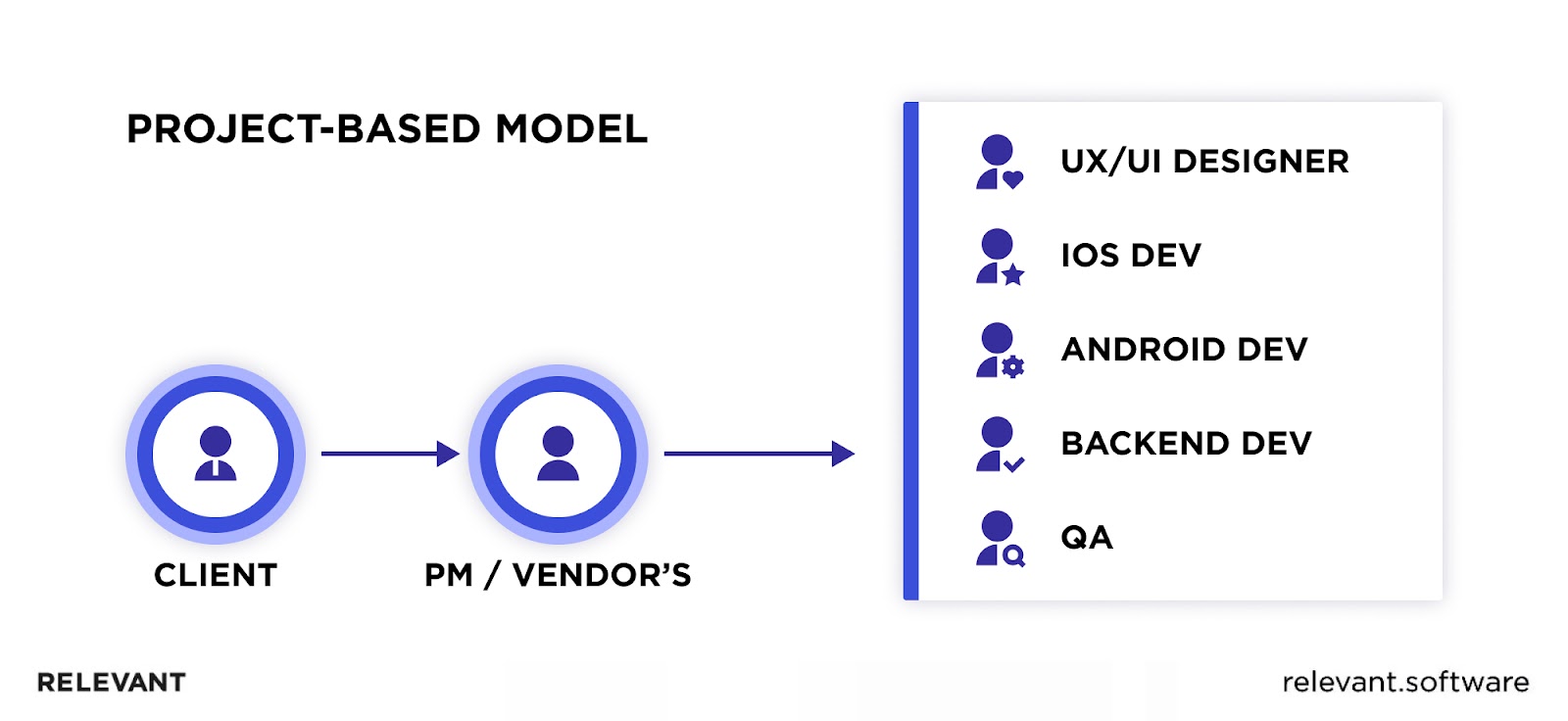
With a project-based approach, you have the least control over the process. It’s the provider who carries out the project management and decides on the team members and tools to complete your project. But, of course, you will get updates on the progress of the work.
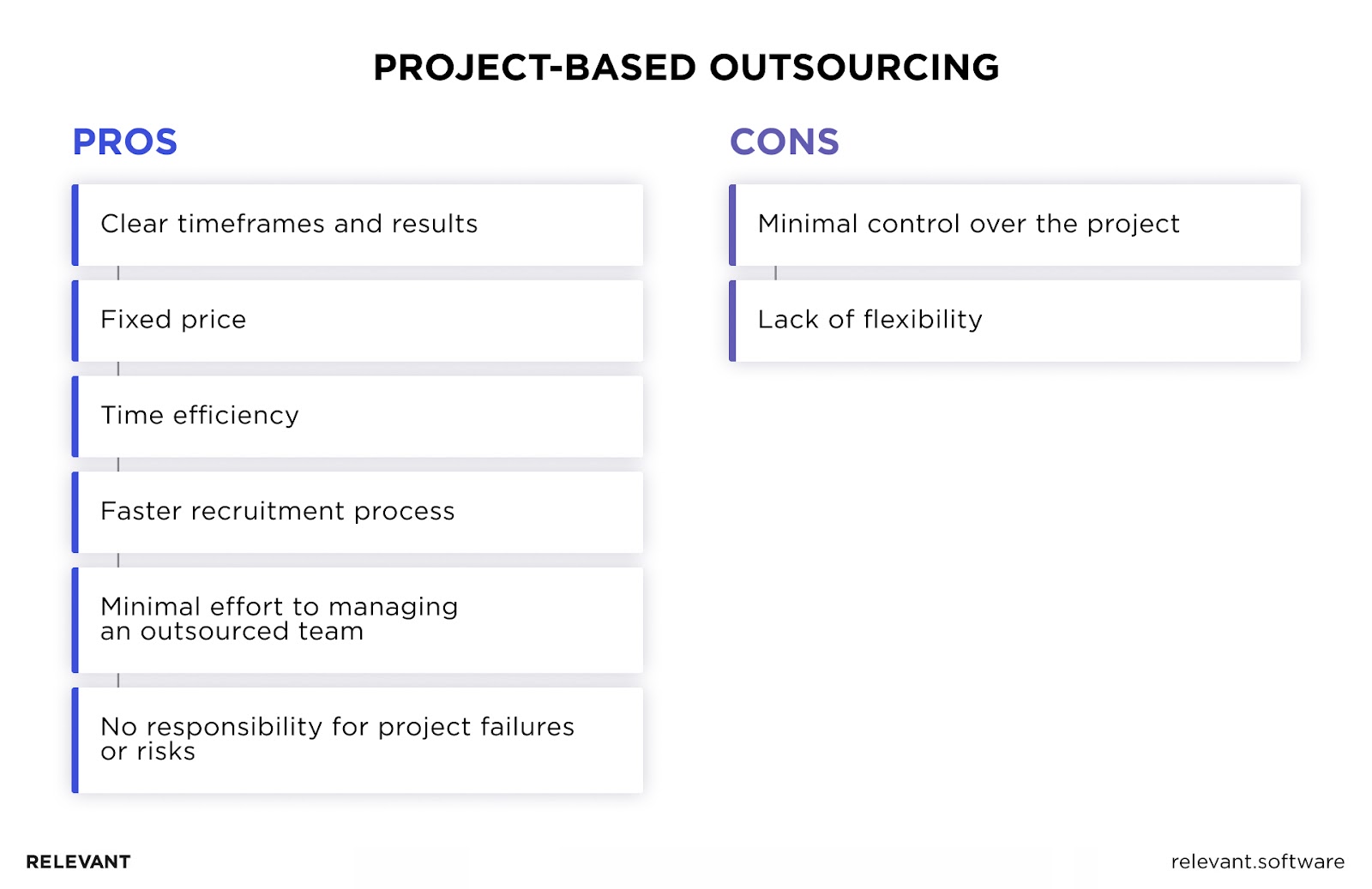
Comparison of Relationship-Based Types of IT outsourcing
Let’s summarize the main points for a quick reference:
| Staff augmentation | Managed team | Project-based | |
| Client involvement | High | Minimum to no | Low |
| Control | High | Minimum to no | Low |
| Flexibility | High | Medium | Low |
| Team scaling | High | Medium | Low |
| Responsibility | Client | Shared | Vendor |
| Project management | Client | Shared | Vendor |
Understanding these basic models will help you adequately strategize the process and avoid potential roadblocks.
Outsourcing Pricing Models
Now, we will cover the possible price structures of the outsourcing deal. It’s an important decision because you should select the payment scheme that makes sense for your organization. So, we highlighted two main types of outsourcing pricing models to help you with the choice.
Fixed Price (FP) model
When choosing this price structure, you pay a fixed price for the services of your vendor agreed upon at the beginning of the project. Your partner will evaluate the scope of work and set the rates based on the estimated resources and time needed to complete the project.
This simple pricing model helps you avoid overpayment. But here’s the trick. You won’t be able to make any changes and adjustments to the project’s scope during product development, which usually happens. Well, actually, you can, but changing them will require a lot of conversations, timelines, and budget changes. As such, projects under fixed price lack flexibility. So, you may choose it for projects with well-defined requirements.
Time and Materials (T&M) model
Using this model, you only pay for the actual time and resources spent on your project. The cost will depend on the hourly rates of software developers and the hours they spend working on your product.
It’s one of the most flexible options among outsourcing pricing models, as you can adjust the process, shift the scope, and make any necessary changes to requirements. That’s why our clients choose the T&M model for most large-scale development projects where the requirements will likely change. Yet keep in mind that there is a possibility of going over your budget due to the project alterations. So, make sure your partner is transparent in their billing to eliminate the potential surprise costs.
Though these are the most popular payment schemes, you can also encounter the following pricing models:
- Consumption-based
- Profit-sharing
- Incentive-based
- Shared risk-reward
Speaking about pricing, you may find it helpful to learn how to estimate the cost of software application development.
How to Choose the Right Outsourcing Model for your Business
Now that you have a grasp of the different types of outsourcing models, we approached the main question: How to select the one that fits your business needs? As a business owner, you should analyze all the aspects of the project that will influence the outcomes. Below we outlined the steps to help you with that.
Consider your business needs
The decision of which functions to keep in-house versus outsourcing should balance the efficient use of augmented staff while leveraging the existing workforce. That’s why you should start by identifying the key issue you want to address through outsourcing and project requirements. Since different needs may fit different outsourcing models, be as specific as possible about the main ones.
Determine the level of control you want to have
As different types of outsourcing services offer different levels of control, you should understand how much of it you may require. For example, you may be comfortable giving up control except for ensuring the outsourced company delivers in line with your requirements. Or you may need more control over the project while leaving the management of the tasks and processes to the external team. Finally, you may want complete control and management responsibility.
Assess the risks and benefits of each outsourcing model
Take the models that potentially fit your business needs and the desired level of control and thoroughly evaluate the pros and cons as well as the risks. Thus, you will clearly understand what you get and what is at stake. And be aware that underestimating possible risks may lead to costly mistakes, so check these tips to avoid IT outsourcing failures.
Look for reputable outsourcing partners
Now, what is left is finding a trustworthy company. As your project specifications are ready, search available options and narrow down the list to companies that best meet your needs. Learn about their tech and business domain expertise, examine portfolios, and read customer reviews. Choose the most relevant companies and ask them to estimate the project. Comparing the estimates will help you select the one. A more detailed guide on the software outsourcing vendor selection process will help you do it more effectively.
Relevant Software – Your Reliable IT Outsourcing Partner
If you are still unsure which one of the outsourcing models to choose in 2024, engage Relevant Software. With the right outsourcing partner, the right outsourcing model usually follows. We work with two collaboration models: a dedicated team and end-to-end development to meet the needs of various projects. Tell us about your software development requirements, and we will guide you through the collaboration and pricing models to find the perfect solution for you.



